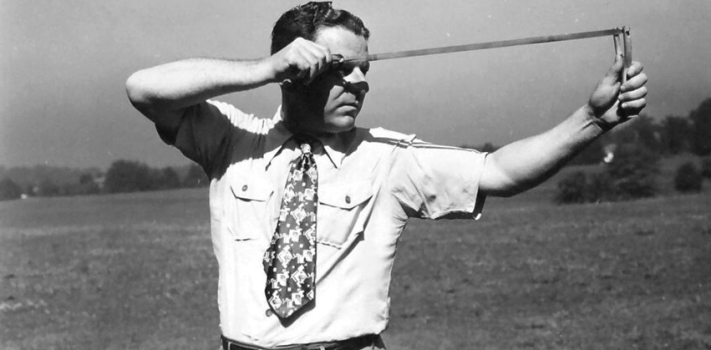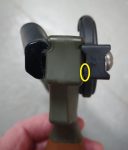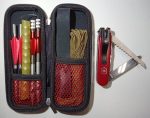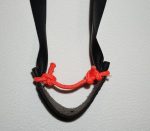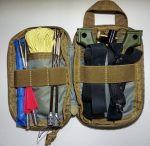(Continued from Part 5. This concludes the article.)
For an inexpensive commercial slingshot the PC Supersonic is an excellent initial option. It costs around $20, is made of super strong polymer and has thumb screws for band attachment, which allows quick band changes in the field. It only supports OTT for band attachment, which works well for most beginners, supports multiple grip styles and comes with a single lighter weight band. It doesn’t have an arrow rest option, but if you search the web for ‘diy slingshot arrow rest’ you can find a number of ways to easily add one.
Moving up in cost, the SimpleShot Scout series is one of the best all-around options available both for beginners as well as advanced users. It’s available in two models – the LT, which works well for smaller hands and is more compact, and the XT which is slightly larger. Both models are $40+shipping, and both come with two medium flat bands with pre-tied pouches. Both the XT and LT use SimpleShot’s Flip Clip and can be configured as either OTT or TTF, and I highly recommend getting the optional thumb screws ($5), which allow easy band changes in the field (there are two different sizes of thumb screws – make sure you get the right ones for your model).
Note that neither of the Scout models have an OEM option for shooting arrows, but it’s relatively easy to add an aftermarket whisker biscuit to the XT model by replacing the FlipClip thumb screw with one that’s 1 ½” long (it’s ¼-20 thread size). You’ll need to drill out the slot in the whisker biscuit’s mounting arm since it’s slightly too narrow for the ¼” bolt. Here’s a picture:
You’ll also need to trim off the bottom ridge on the back of the whisker biscuit mounting arm so it lays flat against the frame – here is a picture that shows where you need to trim (circled in yellow):
As I mentioned earlier, shooting arrows at a decent velocity requires some pretty strong bands and the Scout XT doesn’t have a wrist brace option, but I’ve found that by looping the lanyard tightly around my wrist I can brace it pretty well. I slid some pieces of tubular foam from a floating sunglasses strap over the lanyard to keep it from biting into my wrist too much. The other nice thing about using the lanyard is that it doesn’t qualify as an actual wrist brace under any law that I’ve ever read.
If you’re able to invest some more money and want a complete kit, the SimpleShot Hammer XT bundle is a great option and costs $80. It includes a head with a detachable whisker biscuit attachment, a looped tubular arrow band, two medium flat bands, a Picatinny rail on the bottom and a detachable wrist brace. As with the Scout I recommend you also get the thumbscrews for the FlipClips to simplify band changes in the field. The Hammer is a larger slingshot designed for heavy duty hunting/fishing use and only supports a hammer grip, so if you have smaller hands it might not be comfortable for you. If you don’t want the wrist brace/Picatinny rail option (or it’s not legal in your area), there’s also a smaller and lighter LT handle.
You’ll also need some practice ammo to get started. While you can use rocks, hex nuts, etc., I recommend getting some steel ball ammo for practicing, since it releases cleanly and flies a lot straighter. It’s also durable, so you can re-use the same ammo over and over (assuming you have an ammo catcher and don’t lose it). Although you might be tempted to stock up because it’s so cheap, I recommend just starting with around 100 pieces, which should last you quite a while. 3/8” and 7/16” are some of the most commonly used sizes, and you can usually find 100 or more balls for around $10. Check out some of the slingshot suppliers listed below, or search for ‘3/8” steel ball bearings’ or ‘steel slingshot ammo’ on the web to find some deals.
For hunting small game you’ll want to stock some lead ball ammo, something in the same 5/16”-7/16”size range, depending on the size of the game you’ll be going after and how strong of a band you’re comfortable with. Lead ball ammo tends to deform over time, even just hitting a sheet and the ground, so while you’ll want to do some practice with it I recommend reserving it primarily for actual hunting. You should also consider getting a ball mold so you can make your own ammo from inexpensive lead scrap.
I recommend you stock some of the Sniper Sling hunting darts and stainless steel fishing darts I discussed earlier. If you have an arrow guide for your slingshot, stock up on some hunting and fishing arrows, which you can find inexpensively on a lot of sites. Again: Don’t forget some hand protection for the darts!
For stocking up on bands you can either buy some pre-made bands or rolls of tubing or latex sheet for making your own. As I mentioned earlier, latex and rubber can decay if exposed to UV light, ozone, etc., so store them loosely in mylar bags with oxygen absorbers. If you vacuum seal the bags you’ll most likely be creating sharp creases in the material, which can create weak points over time. The general consensus is that latex can easily survive for at least 5 years if properly protected when stored, and some latex products like gloves have been stored over 10 years in sealed packaging with no noticeable degradation.
You’ll also need to store either pouches or material to make some, which can simply be some pieces of scrap leather, old belts, shoes, etc. I’ve made pouches from thick nylon webbing like seat belt material, although you’ll need to reinforce the band attachment holes to keep them from tearing out.
If you want the most compact slingshot setup possible, learn how to shoot frameless using just a looped band/tube with a pouch attached and include some 3/8” lead ammo in a small coin purse. Adding a couple of SniperSling hunting darts and some fishing darts with line will give you a pretty complete kit that can be quickly deployed. If you’re not comfortable with frameless shooting you could easily include a regular band and just fashion a frame from available materials when you need it.
Here are a couple of examples of kits I put together to add to my BOB/GHB – The first is a bare-bones compact kit stored in a hard pen case. It holds two Sniper Sling hunting darts, two fishing darts, ten 7/16” steel balls in a piece of rubber tubing, 50’ of microcord for the fishing darts and a pre-made band with a pouch. Here’s a picture:
The kit doesn’t contain a frame, but I can easily make one with my Victorinox Hiker (also shown). Alternatively, if you’re comfortable shooting frameless you can include a single looped band and not worry about a frame. Regarding the ball ammo, as I mentioned earlier lead is generally considered better than steel for hunting, but the steel balls are less likely to deform so they can be reused multiple times and they tend to be easier to spot on the ground so I figured they were a better option here.
You may have noticed that there are darts included in the kit, but the band has a pouch attached for the ball ammo. Here’s a little hack that allows me to use a single band for both balls and darts – I take a piece of thin cordage (I use 275 paracord) and tie it snugly across the pouch attachment points, keeping is short enough to fold the pouch. Here’s a picture:
The dart hooks to the string and the pouch sags down out of the way when you draw, allowing you to use a single band without having to switch the pouch for a string. You do have to remove the string when you want to go back to shooting ball ammo. I couldn’t fit in any hand protection for the darts in the kit so I’ll need to improvise something in the field.
The second kit is a little larger and uses a Maxpedition Mini Pocket Organizer. It’s a snug fit, but it holds a SimpleShot Scout LT frame (disassembled and without the handle scales), two Sniper Sling hunting darts, two fishing darts, 100’ of Kevlar line, ten 7/16” steel balls (wrapped in blue painters tape) and two flat bands – one with a ball pouch and one with a string for the darts. Here’s a picture:
It may look tight but you can zip the pouch up with a little bit of wiggling. I plan on putting some small pieces of foam or something over the dart tips to keep them from poking through the pouch
Additional Resources
While I’ve tried to provide as much information as possible to help you understand the value of modern slingshots as a preparedness tool and get you excited enough to try them out, I’ve really only scratched the surface. Here are some additional resources you should investigate:
- Pocket Field Guide: Survival Slingshots, by Creek Stewart – This is a very well-written book on improvising and using a slingshot. I highly recommended it as part of your prep library.
- Fowler’s Makery and Mischief Channel on YouTube – Zachary Fowler has tons of good videos not just on slingshots, but on a lot of other survival-related topics. He also shows a lot of examples of using his skills for real-world survival.
- SimpleShot Academy & FAQs – Lots of good information on slingshots in general as well as SimpleShot products.
- Slingshot World (UK) – Publishers of Slingshot World magazine, with some good online articles, and you can download the first 4 digital editions for free.
- Slingshot Forum – Great place to ask questions and find answers.
- Slingshot Community Forum – Another great source of information and help.
- Slingshot Science – A couple good articles on how slingshots work.
- Joerg Sprave’s Slingshot Channel on YouTube – Joerg makes some of the most interesting and impressive slingshots and slingshot-related devices for sending projectiles downrange (some of which will probably get you a visit by law enforcement), including a lot of good information on how slingshots behave.
Sources of slingshots and supplies (Note: I don’t have any relationship with any of these vendors other than as a customer – I’ve just ordered from them in the past and like them):
Summary
Effective preparedness requires us to leverage lessons of the past while taking advantage of advances in materials and technology to help us improve on them. Slingshots are one tool that has grown well beyond what we played with when we were kids, and they can provide us with an alternative ranged weapons system that can complement or even replace more expensive and complex devices for some hunting, fishing and self-defense scenarios. They offer a combination of unique benefits and are usable by people of all ages, allowing you to get your children more involved in preparedness activities. If you don’t have any recent experience with modern slingshots I strongly urge you to invest some resources to acquire one and learn how to use it effectively.

